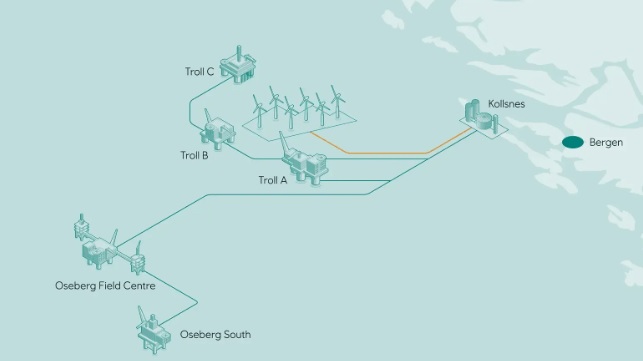Posted on June 22, 2022
State-owned oil major Equinor is taking a big step forward with its floating offshore wind program. Working with TotalEnergies, Shell, ConocoPhillips and Petoro, it has launched a study on options for installing a one gigawatt floating wind farm at the historic Troll offshore oil field area off the coast of Bergen.
The future Trollvind site would connect back to an onshore station, which would receive the electricity and send it back out to the Troll and Oseberg offshore oil and gas platforms. These installations are already electrified using shore power from the Bergen area, and the new wind farm would supplement grid power to provide most of the energy required.
The Troll field’s operating partners will buy the power produced, giving them “greater long-term access to power at a stable price in an area where the power situation is strained.” No government subsidy will be required, and the production price is expected to be less than $0.10 / kwh – about the same as the average retail price in the state of Florida.
Troll is an icon of Norway’s offshore oil and gas industry. When Troll A’s 1,500-foot gravity-based structure was deployed in 1996, it was the tallest manmade object ever moved – a record it still holds today. The field contains about 40 percent of the Norwegian continental shelf’s gas reserves.
“A full-scale floating offshore wind farm like Trollvind could boost momentum towards realizing the Norwegian authorities’ ambition to position Norway as an offshore wind nation, building on expertise from the oil and gas industry,” says Equinor’s chief executive, Anders Opedal.
Equinor effectively launched the sector in 2017 with the deployment of Hywind Scotland, the world’s first commercial floating offshore wind farm.
Equinor is also deploying floating wind at its Hywind Tampen project, a midscale 88 MW development which will supply power to its Snorre and Gullfaks oil and gas platforms. It has also announced plans to build a floating offshore wind farm at Utsira Nord, Norway, and another off the coast of Ulsan, South Korea. Equinor’s bid in the giant ScotWind lease auction last year would have seen it build out another one gigawatt of floating wind capacity, but the proposal lost out amidst fierce competition.
Equinor’s floating wind technology has evolved since it deployed its first prototype in 2009. Since last year, it has transitioned from the floating cable-stayed spar base used at Hywind Scotland to a “technology agnostic” approach. For ScotWind, it proposed to use a conventional welded-steel semisubmersible base. For Hywind Tampen, it is using a concrete spar-shaped base with a shared anchoring system.
According to Equinor, the learning experiences and government-industry partnerships developed in Hywind Tampen will feed into the Trollvind project.






